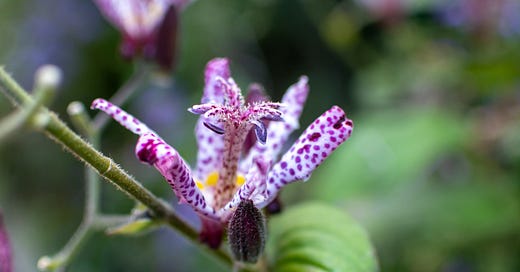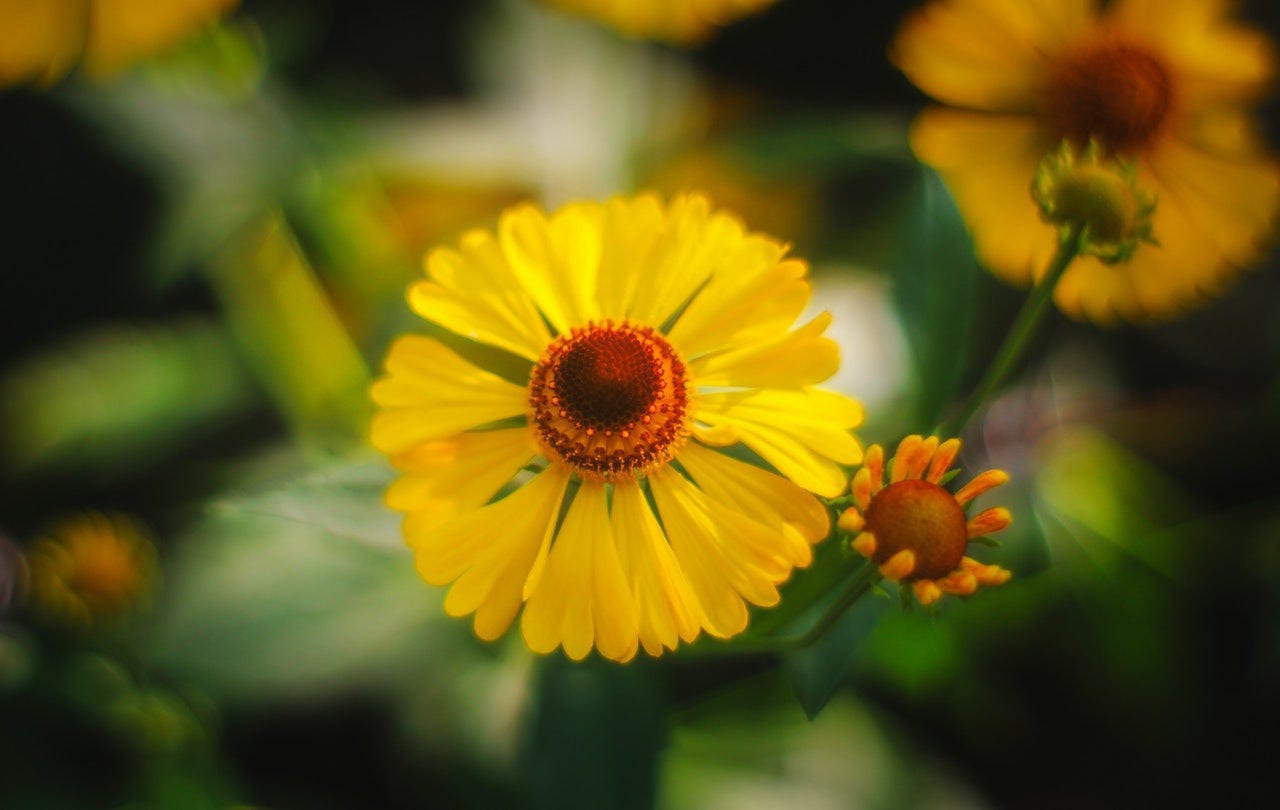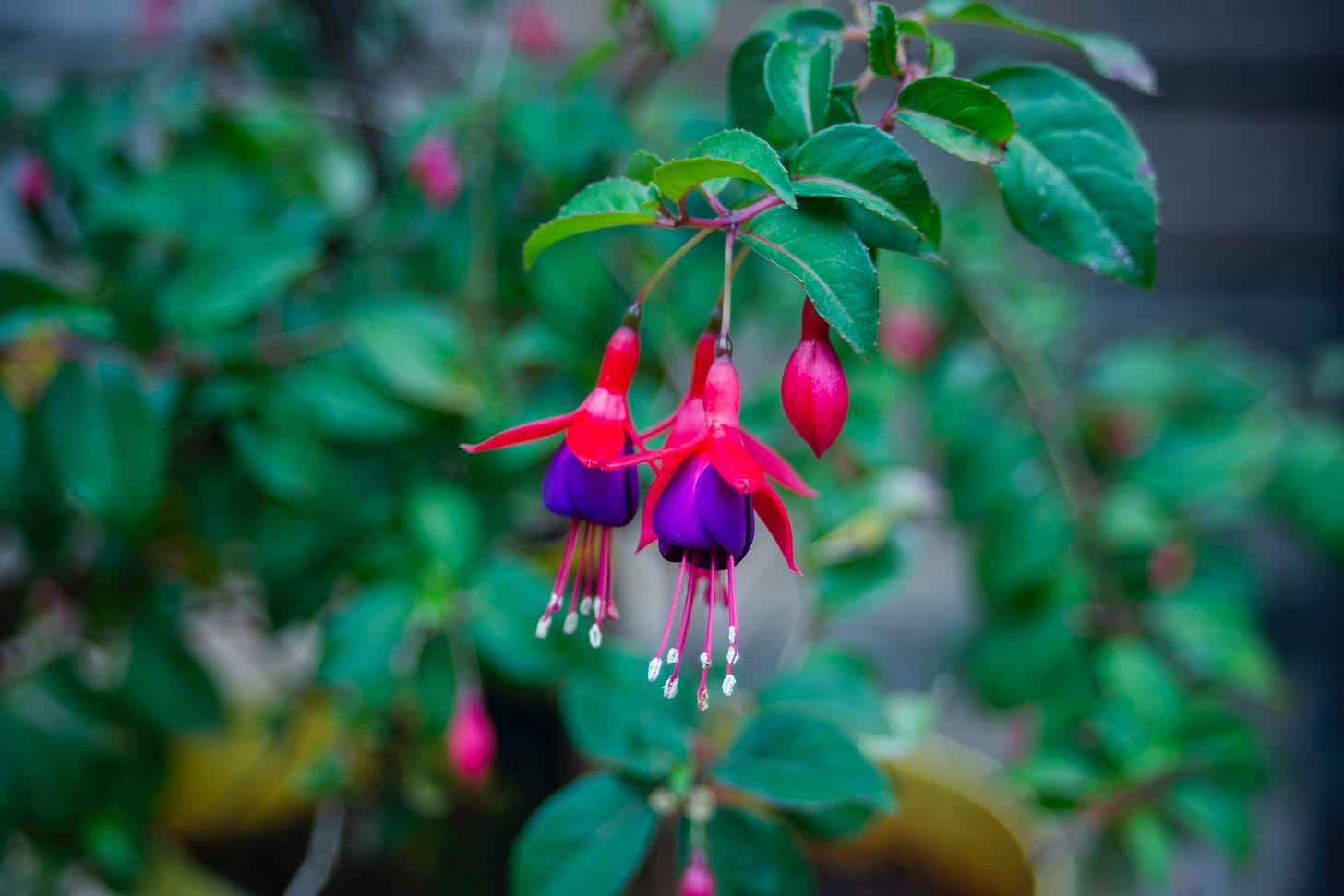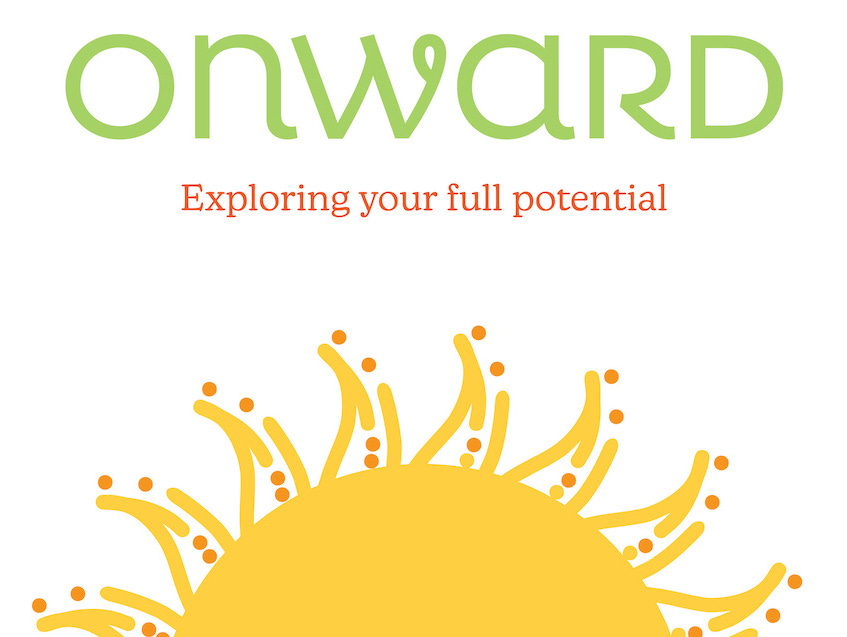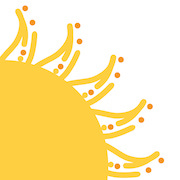Not a subscriber yet? You are missing out! Sign up for the free subscription and you’ll receive emails every other week right in your email inbox. IT’S FREE! As a paying subscriber, you get additional newsletters with exclusive content and access to the full archive ($6 per month, $60 per year). Check it out! You can unsubscribe anytime.☀️
The word late bloomer sparks a floral movie in my head. It reminds me of the term Spätblüher, which in German (my mother tongue) means a flower blossoming in late summer or the fall. When I hear it, images of sweet childhood friends come to my mind: the untiring autumnale sneezeweed with its plentiful yellow heads, toad lilies that charm with orchid-like blooms, and the dancing blossoms of hardy fuchsia my grandmother loved so much, dangling like clusters of little Chinese lanterns.
In German, Spätblüher is usually used in a literal sense, for plants, not for human beings. In English, it seems the other way around: Late bloomer usually refers to a person who blooms late.
What exactly is a human late bloomer? According to the Merriam-Webster dictionary, it is “someone who becomes successful, attractive, etc., at a later time in life than other people.” Similarly, in his book with the same title, author and publisher Rich Karlgaard defines late bloomers as people who fulfill their potential later than expected and often have talents that aren’t visible to others initially.
There are nuances to this. Dean Keith Simonton, professor emeritus at the University of California, Davis, who has researched the lives of outstanding people, distinguishes two types of late bloomers depending on the skills in focus:
- First, the term can refer to abilities most people are likely to develop in their lifetime. These have well-established developmental norms, such as the expected age to walk, speak, and read. A late bloomer in this sense would be a child who learns to speak or read later than most children.
- Second, the term can apply to a specific field only certain people will master, like painting or writing poetry. For example, one study showed that poets typically produce their first notable work between the ages of 25 and 29. “Late-blooming poets” would be artists who create noteworthy poems not until their 40s, 60s, or even 70s.
Cognitive psychologist Barry Scott Kaufman (Columbia University), and a late bloomer himself, suggests a different categorization:
- There is the classic late bloomer, who takes up a specific activity at an advanced age. A prominent example is Grandma Moses, who began painting in earnest after her 75th birthday, gained worldwide fame with her naïve folk-style pictures, and was artistically active until 93.
- Then there are late-recognized bloomers, like the Hungarian-American photographer Andre Kertesz, who for decades received little attention for his unusual photos and only received public recognition in his 80s.
- Finally, there are what Kaufman calls repeat bloomers who flourish multiple times in different areas of life. A well-known exemplar is Ian Fleming, who was a successful journalist, securities trader, and secret agent before he started writing about the adventures of James Bond in his mid-40s.
These examples and definitions point to an important fact. Late bloomers are anything but rare. It is not only prominent people - like the authors Raymond Chandler and Frank McCourt, the KFC founder Colonel Sanders, and the designer Vera Wang - whose achievements came relatively late. Numerous “ordinary” people are flourishing in the later seasons of their lives.
Take Ph.D. students: Most doctoral students are in their 20s and early 30s, but many of their fellow students could be their parents: According to data for 2020 by Statista, 17.5 percent of doctorate recipients in the US were in their 40s, 50s, and 60s.
As timelines shift, late bloomers seem to be getting even more numerous. Research from Stanford University shows that people increasingly accomplish life events - starting a full-time job, getting married, or buying a home - later than previous generations. More outstanding accomplishments come later, too. In entrepreneurship, you can already see the effect: According to the Kauffman Foundation, in 2019, more than 25 percent of new entrepreneurs in the US were between 55 and 65 – in 1996, it was only 15 percent.
A second insight: In contrast to people who reach their potential early in life, each late bloomer progresses on a unique path. “There is only one way of becoming an early bloomer. But there are infinite ways of being a late bloomer,” says psychology professor Simonton.
He explained this to me in more detail in an interview:
Early bloomers discover what they want to do with their lives at an unusually young age and thus get on the developmental track early. They acquire the necessary skills and expertise and then transform the potential they have built up into actual achievements. In contrast, late bloomers initially don’t get on track for a variety of reasons. Maybe they knew what they wanted to do early but were held back by extraneous factors. Or it took them longer than others to ‘find their thing’ because life’s opportunities didn’t afford them the chance to discover a domain that appealed to their interests and talents. Sometimes, life will throw a monkey wrench into their current path, and suddenly they find themselves going in an entirely new and more fruitful direction.
You can easily come up with more categories when you start thinking about it. The slow bloomer, for example, who takes decades to reach the peak. Or the interrupted bloomer who starts early, takes a detour or break, and returns to the original path later.
Late bloomers are unique, colorful, and fascinating - just like their floral namesakes. Yet, people who begin to explore their intellectual, artistic, or other potential relatively late in life often have to put up with critical questions. Going back to school in your 40s: Isn’t that a waste of time? Founding a company at 55: Can she pull it off? Starting a career as an artist at 70: Why didn’t he come up with this project earlier?
There is a widespread fixation on youthful achievement, writes the journalist Hannah Hickok on BBC Worklife: “Given that we’re living longer, switching careers more often and seeking more meaning in our work, it makes sense for more people to ‘bloom’ later in life. And as they do, the stigma of succeeding at an older age – including the idea that it’s less impressive and more surprising than doing so young – is an increasingly outdated and narrow-minded view of age and achievement.”
In fact, research shows that having progressed further in life often comes with significant advantages, for example, greater emotional stability and self-discipline compared to younger years. Even in terms of cognitive abilities, usually regarded as the strength of the young, being older is not necessarily a disadvantage, quite the contrary. While brain functions such as short-term memory, pattern recognition, and reasoning, considered fluid intelligence, peak in young adulthood and then slowly decline, so-called crystallized intelligence (stored knowledge and experiences) does not peak until middle age. The findings of a large US study are even more encouraging for mature folks. It suggests that verbal skills reach their climax not until the seventh decade of life.
On the other hand, (potential) late bloomers face many hurdles: time restrictions due to family obligations, age limits for training courses, adverse reactions from potential employers or clients, physical limitations, self-doubts and insecurities that come with taking an unusual path, to name just a few.
In a later post, I will explore what researchers know about the advantages and challenges in more detail. But today, I want to give somebody the floor who knows about these things from her own experience: Julie Dunne is a British geoarchaeologist who was an accountant for most of her adult life. And then, at the age of 45, she fell in love with the sciences and went back to school to become a researcher. As an older student, Dunne had many doubts if she could pull it off, as she told me in an interview. But she also recognized quite early her advantages as a mature person compared to young students: having more patience, being more organized and methodical, and being able to deal with problems better. She also developed good relationships with her classmates. “There were things I could help the young people with. And they helped me, for example, in a course I had difficulties in because it required a lot of math.”
Embarking on such an adventure takes a lot of commitment, she says. "You have to be sure that you really want to do it because you will probably face a lot of challenges." But if you feel it’s the right thing for you, she would advise everyone to follow her path: “It’s never too late to start a career in science.” For her part, she never regretted her decision to switch careers relatively late in life, she says: "I love my job. I've had so many different experiences and met wonderful people. I love every minute of it.”
Logo & Banner Design by Judy Higgins


